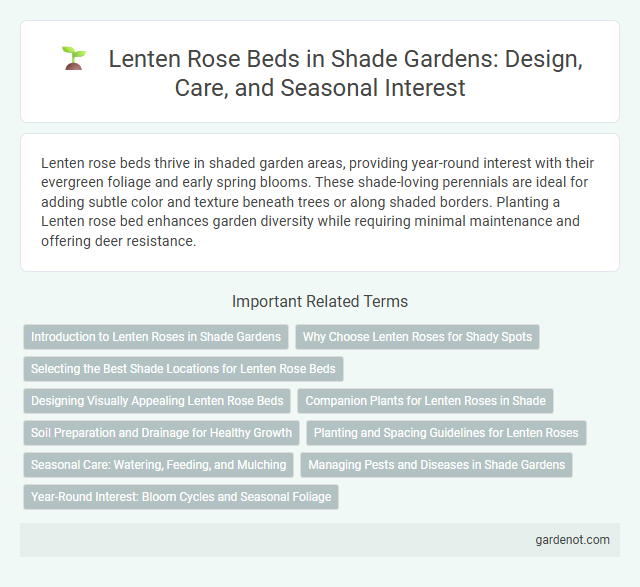Lenten rose beds thrive in shaded garden areas, providing year-round interest with their evergreen foliage and early spring blooms. These shade-loving perennials are ideal for adding subtle color and texture beneath trees or along shaded borders. Planting a Lenten rose bed enhances garden diversity while requiring minimal maintenance and offering deer resistance.
Introduction to Lenten Roses in Shade Gardens
Lenten roses (Helleborus spp.) thrive in shade gardens by offering early spring blooms that brighten dark, shaded areas. These evergreen perennials are valued for their tolerance to low light and their ability to flourish under tree canopies or beside shrubs. Their long-lasting, nodding flowers come in various colors, providing visual interest and enhancing shade garden diversity.
Why Choose Lenten Roses for Shady Spots
Lenten roses thrive in shady garden areas due to their exceptional tolerance for low light and cold conditions, making them ideal for under tree canopies or north-facing slopes. Their early bloom period, often from late winter to early spring, provides vibrant color when most other plants remain dormant, enhancing visual interest in dim garden spots. Hardy and low-maintenance, Lenten roses also resist deer and pests, ensuring a reliable, long-lasting addition to any shade garden.
Selecting the Best Shade Locations for Lenten Rose Beds
Lenten rose (Helleborus orientalis) flourishes in well-drained, humus-rich soil and thrives best in shaded or partially shaded areas, making north-facing garden beds ideal for its growth. Choose locations beneath deciduous trees or alongside evergreen shrubs where dappled sunlight filters through, protecting the plants from harsh afternoon sun and ensuring steady moisture retention. Optimizing shade conditions reduces leaf scorch and encourages prolonged blooming periods from late winter to early spring.
Designing Visually Appealing Lenten Rose Beds
Design visually appealing Lenten rose beds by selecting a variety of Helleborus cultivars with diverse flower colors and foliage textures to create depth and contrast. Incorporate layered planting with evergreen groundcovers and shade-loving perennials to enhance year-round interest while ensuring adequate spacing for airflow and growth. Mulch with organic material to maintain soil moisture and prevent weed growth, complementing the natural elegance of the Lenten roses.
Companion Plants for Lenten Roses in Shade
Lenten roses (Helleborus orientalis) thrive in shaded garden beds paired with companion plants like hostas, ferns, and astilbes, which complement their early spring blooms and provide contrasting foliage textures. These shade-loving perennials enhance soil moisture retention and create a lush understory, promoting healthy growth for the Lenten rose. Incorporating hellebores with Japanese forest grass and Solomon's seal also adds seasonal interest and biodiversity to shaded garden environments.
Soil Preparation and Drainage for Healthy Growth
Lenten rose thrives in well-drained, rich soil with a pH ranging from 6.5 to 7.5, promoting nutrient retention and root health. Incorporate organic matter like compost or leaf mold to enhance soil structure and moisture regulation, preventing waterlogging that harms roots. Proper drainage can be achieved by amending heavy clay soils or planting on raised beds, ensuring excess water flows away to support vigorous, healthy growth.
Planting and Spacing Guidelines for Lenten Roses
Lenten roses (Helleborus spp.) thrive in well-drained, humus-rich soil with partial to full shade, making them ideal for shade garden beds. Plant Lenten roses 12 to 18 inches apart to allow adequate air circulation and prevent overcrowding, which reduces the risk of fungal diseases. Ensure the crown is positioned slightly above soil level to promote healthy growth and facilitate watering at the base.
Seasonal Care: Watering, Feeding, and Mulching
Lenten rose beds thrive with consistent watering to maintain evenly moist soil, especially during dry spells in spring and summer. Applying a balanced, slow-release fertilizer in early spring supports robust growth and prolonged blooming. Mulching with organic materials such as shredded leaves or bark conserves soil moisture, suppresses weeds, and enriches the soil as it decomposes.
Managing Pests and Diseases in Shade Gardens
Lenten rose beds in shade gardens require vigilant monitoring for common pests like aphids and slugs, which can damage foliage and flowers. Applying organic insecticidal soaps and encouraging beneficial insects such as ladybugs helps maintain pest populations at manageable levels. Preventing fungal diseases involves ensuring proper air circulation and avoiding overhead watering to keep leaves dry and healthy.
Year-Round Interest: Bloom Cycles and Seasonal Foliage
Lenten rose beds provide year-round interest with their extended bloom cycles, typically flowering from late winter to early spring, brightening shady garden spaces during colder months. Their evergreen foliage shifts in color through seasons, often deepening to rich purples or bronze hues in winter and returning to vibrant greens in summer. This resilient plant combination ensures a dynamic shade garden with continuous visual appeal across all seasons.
Lenten rose bed Infographic

 gardenot.com
gardenot.com